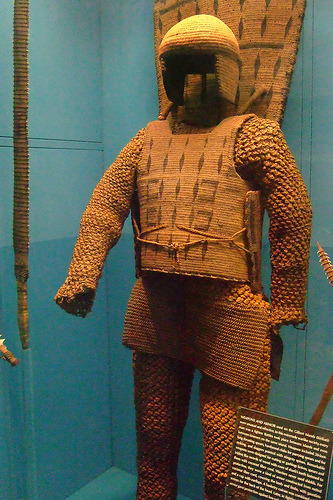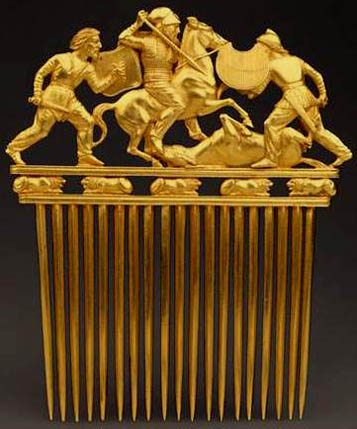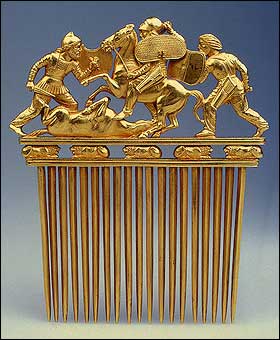| Author |
Message |
Daniel Wallace

Location: Pennsylvania USA Joined: 07 Aug 2011
Posts: 580
|
 Posted: Tue 27 Aug, 2013 8:19 am Post subject: Posted: Tue 27 Aug, 2013 8:19 am Post subject: |
 |
|
what type of fire arm are we considering the armor to be proof from? 16th century pistol or musket?
i don't think there's much of any armor from the period that could survive a round from a musket/flintlock whichever is considered for the period.
pistol on the other hand - doesn't have as great a charge, but the only armors I've seen photographed and represented as proof against those are European steel.
|
|
  |
 |
Alex Cerioli

Location: Italia Joined: 26 Aug 2013
Posts: 24
|
 Posted: Tue 27 Aug, 2013 9:50 am Post subject: Posted: Tue 27 Aug, 2013 9:50 am Post subject: |
 |
|
I think it mostly depend by the range you shoot with a musket of that era, if the target is at its ballistic limit an armour like that can save his life:
http://en.wikipedia.org/wiki/Ballistic_limit
And of course this armour, made or leather of whatever material will offer more protection and shorter "ballistic limit" than plan clothes.
|
|
  |
 |
|
Philip Dyer
|
 Posted: Tue 27 Aug, 2013 10:39 am Post subject: Posted: Tue 27 Aug, 2013 10:39 am Post subject: |
 |
|
| Daniel Wallace wrote: | what type of fire arm are we considering the armor to be proof from? 16th century pistol or musket?
i don't think there's much of any armor from the period that could survive a round from a musket/flintlock whichever is considered for the period.
pistol on the other hand - doesn't have as great a charge, but the only armors I've seen photographed and represented as proof against those are European steel. |
I've read that early modern pistols were so weak that it took them being shoved into a person bodies to guarantee a kill againist a person wearing a buff coat. Rasputin in the early 20th century supposily survived several bullet wounds along and Jackson did in a duel in the early 19th century.
|
|
  |
 |
Eric S

|
 Posted: Wed 28 Aug, 2013 11:09 pm Post subject: Posted: Wed 28 Aug, 2013 11:09 pm Post subject: |
 |
|
| Daniel Wallace wrote: | what type of fire arm are we considering the armor to be proof from? 16th century pistol or musket?
i don't think there's much of any armor from the period that could survive a round from a musket/flintlock whichever is considered for the period.
pistol on the other hand - doesn't have as great a charge, but the only armors I've seen photographed and represented as proof against those are European steel. |
Tameshi gusoku (bullet tested armor), was the method used by armor makers in Japan to show how resistant their armor was to matchlock bullets. By firing a bullet at various individual panels, a purchaser could see how effective the armor he was thinking of buying would be against gunfire. Armor damaged by gunfire in battle would have been repaired and lacquered again leaving no trace of the damage. In most cases the bullet marks seen in existing samurai armor are tameshi marks and not actual battle damage despite the claims of the owner or dealer. On tameshi gusoku the shots were fired before lacquer was applied and the armor was then finished leaving the marks in the armor as proof.

|
|
   |
 |
|
Philip Dyer
|
 Posted: Thu 29 Aug, 2013 5:52 am Post subject: Posted: Thu 29 Aug, 2013 5:52 am Post subject: |
 |
|
| Eric S wrote: | | Daniel Wallace wrote: | what type of fire arm are we considering the armor to be proof from? 16th century pistol or musket?
i don't think there's much of any armor from the period that could survive a round from a musket/flintlock whichever is considered for the period.
pistol on the other hand - doesn't have as great a charge, but the only armors I've seen photographed and represented as proof against those are European steel. |
Tameshi gusoku (bullet tested armor), was the method used by armor makers in Japan to show how resistant their armor was to matchlock bullets. By firing a bullet at various individual panels, a purchaser could see how effective the armor he was thinking of buying would be against gunfire. Armor damaged by gunfire in battle would have been repaired and lacquered again leaving no trace of the damage. In most cases the bullet marks seen in existing samurai armor are tameshi marks and not actual battle damage despite the claims of the owner or dealer. On tameshi gusoku the shots were fired before lacquer was applied and the armor was then finished leaving the marks in the armor as proof.
 |
That cools like a helmet and was this done with a pistol or a musket?
|
|
  |
 |
|
Ruel A. Macaraeg
|
|
    |
 |
|
Michael Wiethop
Location: St. Louis Joined: 27 May 2012
Posts: 63
|
 Posted: Thu 29 Aug, 2013 1:42 pm Post subject: Posted: Thu 29 Aug, 2013 1:42 pm Post subject: |
 |
|
If I recall those flaps on the armor's neck of those Inuit and Chukchi are meant to protect against arrows. The user simply turns around for full protection. Of course, this would come at the expense of visibility and the ability to fight back, so this might not be the actual reason.
Some more examples:

This is armor from Kiribati is made of coconut fibers, and has a similar neck shield:

|
|
  |
 |
|
Timo Nieminen
|
 Posted: Thu 29 Aug, 2013 2:57 pm Post subject: Posted: Thu 29 Aug, 2013 2:57 pm Post subject: |
 |
|
| Michael Wiethop wrote: | This is armor from Kiribati is made of coconut fibers, and has a similar neck shield:
 |
This I have read (probably in Stone's Glossary) is to protect from friendly fire. The front-rank fighters are armours, and carry clubs. The rear-rankers are mostly stone-throwers. Armour the rear well, and they can continue to help even when the front ranks are fighting.
"In addition to being efficient, all pole arms were quite nice to look at." - Cherney Berg, A hideous history of weapons, Collier 1963.
|
|
   |
 |
|
Michael Wiethop
Location: St. Louis Joined: 27 May 2012
Posts: 63
|
 Posted: Thu 29 Aug, 2013 6:16 pm Post subject: Posted: Thu 29 Aug, 2013 6:16 pm Post subject: |
 |
|
|
Yes, I recall reading a blurb about that as well. I also remember seeing some old woodcut of a Native American, captioned as an Iroquois, I think, in a suit of wooden armor with a neck guard similar to that on the Chukchi armor. I can't seem to find this picture anymore, though.
|
|
  |
 |
|
Ruel A. Macaraeg
|
 Posted: Thu 29 Aug, 2013 7:12 pm Post subject: Posted: Thu 29 Aug, 2013 7:12 pm Post subject: |
 |
|
Yes, this is a design that emerged independently several times throughout history: The Bering Strait (Chuckhi-Koryak, Pacific/Asian Eskimo), Iroquois/Huron 17thc (Michael, that illustration appears in Taylor 2001 and elsewhere as Huron), Mississippian Moundbuilders, 5th-4thc BC Scythians, and Kiribati, to name some. Timo, I've transcribed Stone's Kiribati quote in the linked page below, though I'm not quite convinced that's what these were for.
http://www.forensicfashion.com/1840KiribatiWarrior.html
http://ForensicFashion.com/CostumeStudies.html
|
|
    |
 |
Dan Howard

|
 Posted: Thu 29 Aug, 2013 7:36 pm Post subject: Posted: Thu 29 Aug, 2013 7:36 pm Post subject: |
 |
|
The Scythians did it differently. Apparently it was a regular shield that was wielded in the hand, but it could be slung horizontally over the back to protect the head and shoulders.
Robert Louis Stevenson's journals would probably be a better source than Stone for studying Kiribati arms and warfare.
|
|
  |
 |
|
Ruel A. Macaraeg
|
 Posted: Fri 30 Aug, 2013 7:55 am Post subject: Posted: Fri 30 Aug, 2013 7:55 am Post subject: |
 |
|
Seems like there were at least two kinds of Scythian shields, a "normal" kind like you refer to, and one of these back-attached ones that was held in place by some harness arrangement. The second type was reconstructed from a tomb find in the first photo below, and appears to be worn by the central rider in the famous Hermitage comb. From the reverse angle you can see that the rider's hands are both free so it's either slung or fixed, though it looks rather more fixed because it seems to rest very evenly across his shoulders and back. (Gorelik 1995 also reconstructs it this way.)

 
http://ForensicFashion.com/CostumeStudies.html
|
|
    |
 |
|
Lafayette C Curtis
|
 Posted: Thu 05 Sep, 2013 5:22 am Post subject: Posted: Thu 05 Sep, 2013 5:22 am Post subject: |
 |
|
| Philip Dyer wrote: | | I've read that early modern pistols were so weak that it took them being shoved into a person bodies to guarantee a kill againist a person wearing a buff coat. Rasputin in the early 20th century supposily survived several bullet wounds along and Jackson did in a duel in the early 19th century. |
I'm afraid this mixes together several different periods and circumstances that have very little to do with each other. Early pistols in the 16th and the 17th centuries were specifically designed to penetrate armour; they had long barrels and fired relatively small balls at fairly high velocity, and often used steel balls that wouldn't deform upon hitting a hard target as lead balls would. The problem was armour-makers rose to the challenge and made heavier armour that could resist pistol shot at all but the closest ranges (and sometimes even then), at the cost of being so heavy that soldiers hated wearing it for more than just a few hours at a time. Later on in the second half of the 17th century, when the vast majority of soldiers had shed all (or nearly all) of their heavy pistol-proof armour, the armour-piercing capabilities of the pistol became less necessary and it evolved into a weapon firing larger balls at a lower velocity, all the better for hurting unarmoured targets at the same (i.e. very short) ranges.
The fact that a single pistol ball or bullet could fail to kill a man is no surprise at all. Modern firearm training acknowledges that no hit from a pistol round could be guaranteed to stop the target unless it struck the brain or the central nervous system; indeed, many people have suffered non-survivable hits to vital organs (such as the heart or major blood vessels) and kept on fighting for several more seconds or minutes until they had finally lost enough blood to fall unconscious. This doesn't make the pistol a weak or ineffective weapon in its own right; it's just that any sane and knowledgeable user must acknowledge its limitations in terms of power and accuracy.
|
|
  |
 |
Benjamin H. Abbott

|
 Posted: Fri 06 Dec, 2013 2:11 pm Post subject: Posted: Fri 06 Dec, 2013 2:11 pm Post subject: |
 |
|
|
As far as bulletproof Chinese armor goes, a 17th-century Dutch source claims the coats of "iron scales" used by Koxinga's forces afforded them complete protection from rifle bullets. Koxinga expelled the Dutch from Taiwan in the 1660s.
|
|
  |
 |
|
|

